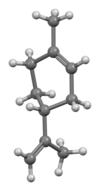Limonene (R)-isomer
| |||
 Limonene extracted from orange peel
| |||
| Names | |||
|---|---|---|---|
| Preferred IUPAC name
1-Methyl-4-(prop-1-en-2-yl)cyclohex-1-ene | |||
| Other names
1-Methyl-4-(1-methylethenyl)cyclohexene
4-Isopropenyl-1-methylcyclohexene p-Menth-1,8-diene Racemic: DL-Limonene; Dipentene | |||
| Identifiers | |||
3D model (JSmol)
|
|||
| ChEBI | |||
| ChEMBL |
| ||
| ChemSpider | |||
| ECHA InfoCard | 100.004.856 | ||
| KEGG | |||
PubChem CID
|
|||
| UNII |
| ||
CompTox Dashboard (EPA)
|
|||
| |||
| |||
| Properties | |||
| C10H16 | |||
| Molar mass | 136.238 g·mol−1 | ||
| Appearance | colorless liquid | ||
| Odor | Orange | ||
| Density | 0.8411 g/cm3 | ||
| Melting point | −74.35 °C (−101.83 °F; 198.80 K) | ||
| Boiling point | 176 °C (349 °F; 449 K) | ||
| Insoluble | |||
| Solubility | Miscible with benzene, chloroform, ether, CS2, and oils soluble in CCl4 | ||
Chiral rotation ([α]D)
|
87–102° | ||
Refractive index (nD)
|
1.4727 | ||
| Thermochemistry | |||
Std enthalpy of
combustion (ΔcH⦵298) |
−6.128 MJ mol−1 | ||
| Hazards | |||
| Occupational safety and health (OHS/OSH): | |||
Main hazards
|
Skin sensitizer / Contact dermatitis – After aspiration, pulmonary oedema, pneumonitis, and death[1] | ||
| GHS labelling: | |||
   
| |||
| Danger | |||
| H226, H304, H315, H317, H410 | |||
| P210, P233, P235, P240, P241, P242, P243, P261, P264, P272, P273, P280, P301+P330+P331, P302+P352, P303+P361+P353, P304+P340, P312, P333+P313, P362, P370+P378, P391, P403+P233, P405, P501 | |||
| NFPA 704 (fire diamond) | |||
| Flash point | 50 °C (122 °F; 323 K) | ||
| 237 °C (459 °F; 510 K) | |||
Except where otherwise noted, data are given for materials in their standard state (at 25 °C [77 °F], 100 kPa).
| |||
Limonene (/ˈlɪmənˌiːn/) is a colorless liquid aliphatic hydrocarbon classified as a cyclic monoterpene, and is the major component in the essential oil of citrus fruit peels.[1] The (+)-isomer, occurring more commonly in nature as the fragrance of oranges, is a flavoring agent in food manufacturing.[1][2] It is also used in chemical synthesis as a precursor to carvone and as a renewables-based solvent in cleaning products.[1] The less common (-)-isomer has a piny, turpentine-like odor, and is found in the edible parts of such plants as caraway, dill, and bergamot orange plants.[3]
Limonene takes its name from Italian limone ("lemon").[4] Limonene is a chiral molecule, and biological sources produce one enantiomer: the principal industrial source, citrus fruit, contains (+)-limonene (d-limonene), which is the (R)-enantiomer.[1] (+)-Limonene is obtained commercially from citrus fruits through two primary methods: centrifugal separation or steam distillation.
- ^ a b c d e "D-Limonene". PubChem, US National Library of Medicine. 11 May 2024. Retrieved 18 May 2024.
- ^ Cite error: The named reference
Ullmannwas invoked but never defined (see the help page). - ^ "Molecule of the Week Archive: Limonene". American Chemical Society. 1 November 2021. Retrieved 5 November 2021.
- ^ "limonene". merriam-webster.com. Merriam-Webster. 22 September 2023. Retrieved 23 September 2023.


